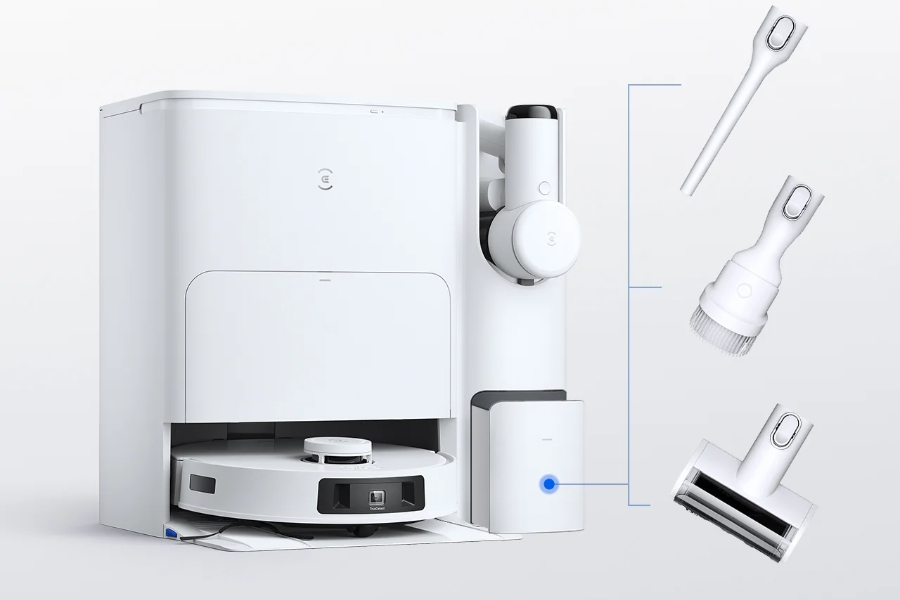How Do Vacuum Robots with Mapping Navigate?
2024-11-06

When we talk about revolutionary home cleaning devices, robot vacuums – arguably the most popular smart home device on the market – will definitely come to mind. How does a robot vacuum know where to go and navigate through the obstacles? These intelligent devices combine advanced sensors, mapping algorithms, and artificial intelligence that can detect and map your house strategically. Unlike traditional models that follow preset patterns, robot vacuums with mapping capabilities take a systematic approach to efficiently clean the space without missing spots.
If you're thinking about getting a robot vacuum with mapping and want to learn more about this technology, you're in the right place.
How Do Robot Vacuum Navigate
Robot vacuums use different technology and sensors to navigate your home. Generally, smart vacuums start by mapping the environment – utilizing cameras, lasers, or infrared sensors to create a detailed map. After scanning the surroundings to detect walls, furniture and other objects, they then process the data and generate a map that will serve as a reference for planning efficient cleaning paths. While different brands and models of robot vacuums may use distinct types of sensors, they typically feature obstacle sensors, cliff sensors and wall sensors. For example, our DEEBOT robot vacuums uses LiDAR technology with DToF laser sensor to build precise 3D maps, allowing them to recognize obstacles like furniture and stray toys, and adjust the cleaning path without delays.
How Does Robot Vacuum Mapping Work
In a robot vacuum, mapping works by scanning the environment with cameras and sensors to create a map for path planning.
As a leading robot vacuum manufacturer, we employ the AINA 2.0 Intelligent Navigation Model system to enhance navigation capabilities in DEEBOTs. By combining deep learning and reinforcement learning technologies with dToF sensors, these smart vacuums provide real-time navigation and obstacle avoidance responses.
When it comes to object avoidance, the enhanced AIVI 3D 2.0 technology recognizes furniture, rooms, and obstacles via an auto-grade 960P star-light level camera and RGBD sensors. With strategic avoidance, disruptions during the cleaning process are minimized.
Since the technologies mentioned above do not rely on ambient light, DEEBOT robot vacuums perform equally well even in dark environments.

Best DEEBOT Robot Vacuums With Mapping Technology

With the rapid development in the mapping and navigation system, DEEBOTs not only greatly provides unbeatable cleaning efficiency, but also saves you more time to enjoy life with friends and families. Here’s three best DEEBOT robot vacuums with mapping.
DEEBOT X5 PRO OMNI

DEEBOT X5 PRO OMNI sets a new standard in robotic cleaning with its AINA 2.0 Intelligent Navigation Model, which enables real-time navigation and obstacle avoidance. With AI-powered navigation around furniture and obstacles, this auto vacuum provides a thorough clean on various floor types with a powerful suction of 12,800Pa1.
DEEBOT T30S COMBO

DEEBOT T30S COMBO features advanced TrueDetect 3D 3.0 technology for precise obstacle avoidance and TrueMapping 2.0 for rapid mapping, allowing it to create accurate room layouts: up to 100 square meters in just six minutes. The other highlighted features include TruEdge Adaptive Edge Mopping for thorough cleaning along walls, and the ZeroTangle Anti-Tangle Technology for reducing hair entanglement and a hassle-free cleaning experience.
DEEBOT N20 PLUS

With TrueMapping Intelligent Path Planning, DEEBOT N20 PRO PLUS maps an area of 100 square meters in just eight minutes. Its reliable obstacle avoidance technology allows it to navigate over obstacles up to 20mm high effortlessly; when coupled with 8000Pa suction power and a 4-Stage Filtration System, it guarantees a thorough clean to maintain a fresh living environment.
FAQ
Are mapping robot vacuums better?
Yes, the mapping technology, such as the TrueMapping 2.0 and AIVI 3D technology employed in ECOVACS DEEBOT, help robot vacuums to navigate more efficiently and accurately, avoid obstacles in real time and plan the most efficient cleaning path with no missing spots. Since it is laser based, it doesn’t require a bright environment to work. The robot vacuum can function equally well in dark conditions. With an advanced mapping system, robot vacuum comes with customizing features like virtual boundaries for a smarter and tailored cleaning experience.
Do all robot vacuums have mapping?
No, not all robot vacuums have mapping capabilities. Basic or entry-level models typically rely on random or pattern-based navigation, while mapping technology is found in more advanced and higher-end robot vacuums.
How long does it take for a robot vacuum to map your house?
The time it takes for a robot vacuum to map your house can vary depending on the size of the area, the layout, and the mapping capabilities of the robot vacuum. Generally speaking, it takes anywhere from a few cleaning sessions to several hours to complete the initial mapping process.
Is mapping important for robot vacuum cleaners?
Yes, mapping is very important for robot vacuum cleaners. Mapping supports the navigation and obstacle avoidance system, as well as systematic cleaning planning. Advanced mapping technologies allows better coverage during cleaning.
What are the different types of robot vacuum navigation?
In a robot vacuum, common navigation systems include: random navigation, gyroscopic navigation, laser-based navigation, and camera-based mapping. With different precision and efficiency, the navigation technology impacts the overall cleaning performance.
Disclaimer(s):
- 12,800Pa: This data comes from ECOVACS laboratory. The suction power of DEEBOT X5 PRO OMNI can reach 12,800Pa.
Related Products









